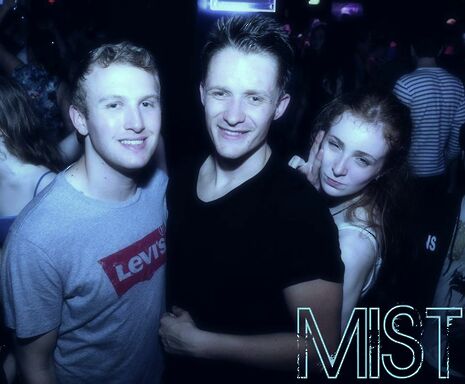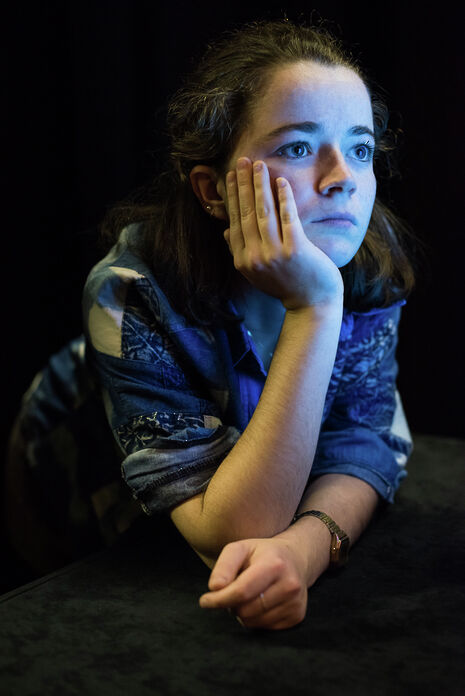VK and broken dreams: Post-Cambridge theatre in MIST: Diazepam
‘Magnify tenfold the existential crises and “broken dreams” of a VK-fueled night in Cindies and you’re probably close to the nihilistic atmosphere of this play’, writes Sam Brown

“Is this post-Cambridge theatre?” – Zoe Black, current President of the Fletcher Players.
Quite possibly Zoe, yes. MIST: Diazepam, the brainchild of Johnny King and Carine Valarché, aims to stretch the boundaries of Cambridge theatre through a potent mixture of outrageous publicity campaigning, innovative linking of genres, and an intriguing use of space.
Set in a future in which an oppressive, unseen government seeks to destroy any potential for depression amongst its citizens through a blitz of compulsory medication, MIST hones in on an oasis in this bleak landscape: the final bar in town. This setting and narrative remain relatively stable throughout, until “a moment of intense crisis,” as co-director King puts it, is reached.
“Co-director Johnny King said that their aim was to create a “social hospice of broken people” within a familiar setting”
Led by veteran compere Sydney Diazepam (Harry Burke), MIST takes us on a quick-fire exploration of future bar culture and the relationships between the drinkers in this speakeasy. Opening with Sydney’s thrilling line: “Welcome one and all to MIST…the final bar floating in an ocean of broken dreams and lonely corners”, the play is indeed an analysis of fragmentation – fragmentation of the self and of the concepts and vocabularies surrounding mental health.
Co-director Johnny King said that their aim was to create a “social hospice of broken people” within a familiar setting. Magnify tenfold the existential crises and “broken dreams” of a VK-fueled night in Cindies and you’re probably close to the nihilistic atmosphere of this play.
An imaginatively-named character list includes figures such as the enigmatic Viscera Skye (Annabel Bolton), Peta Blocker (Jo Heywood), Ivanka (Ella Sbaraini), Saliva Simone (Carine Valarché), and Riley Flippant (Clodagh Kelsh). From my brief viewing of their first full run-through, they are all capable of capturing the complexities of their individual characters.

However, King was honest about both the fraught and amusing origins of the production. The play was initially conceived as part of a “joke-application” to the Downing Dramatic Society. After being accepted and provided with a surprisingly high budget, the two directors had just ten days to produce a finished script: an impressive feat.
MIST’s publicity campaign is deserving of the description ‘post-Cambridge theatre’. Setting up a realistic Facebook club page – complete with cheesy club photos, rave reviews and fictional events - was an ingenuous move, provided people don’t become too confused by the supreme ‘meta-ness’ of it.
“In short, MIST: Diazepam looks to be travelling at an intriguing tangent to the rest of Cambridge theatre”
Similarly, the risky ploy of portraying the fictional MIST club as ‘presenting the Union Ball’ was a new but controversial method of creating a public buzz about the play. As expected, the Union queried the appropriation of their event, although King explains that they actually have no legal ownership of the term.
Original music written by King provides cabaret-like interludes, while trained gymnasts perform at various choice moments, adding final layers of complexity to what is already a textured and multifaceted production. Both such elements combine with a minimalist costume aesthetic to present the ‘retro of the future.’ As King says, “bars often relate back to the fashions and trends of the decades before them, and it was therefore fun to explore how the bars of the future will conceive of the retro or hipster.”

In short, MIST: Diazepam looks to be travelling at an intriguing tangent to the rest of Cambridge theatre, exploring new ways of getting its name heard, commenting on present day drinking habits, and realising an original and thought-provoking premise.
Most of all, however, the play appeals due to its intense characterisation of broken figures, each with their individual wants and woes. Such a relatable yet perplexing production should not be missed
 Features / Should I stay or should I go? Cambridge students and alumni reflect on how their memories stay with them15 December 2025
Features / Should I stay or should I go? Cambridge students and alumni reflect on how their memories stay with them15 December 2025 News / Cambridge study finds students learn better with notes than AI13 December 2025
News / Cambridge study finds students learn better with notes than AI13 December 2025 News / Dons warn PM about Vet School closure16 December 2025
News / Dons warn PM about Vet School closure16 December 2025 News / News In Brief: Michaelmas marriages, monogamous mammals, and messaging manipulation15 December 2025
News / News In Brief: Michaelmas marriages, monogamous mammals, and messaging manipulation15 December 2025 Comment / The magic of an eight-week term15 December 2025
Comment / The magic of an eight-week term15 December 2025








